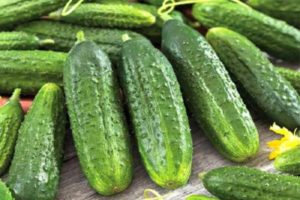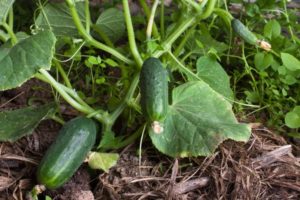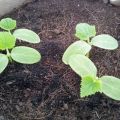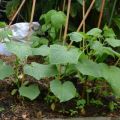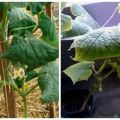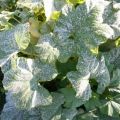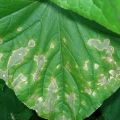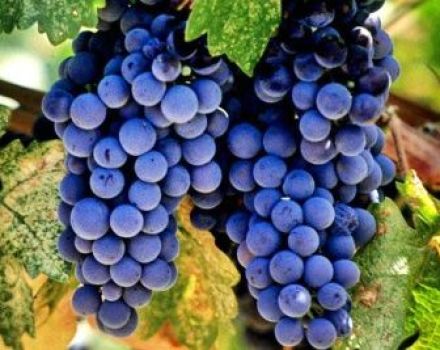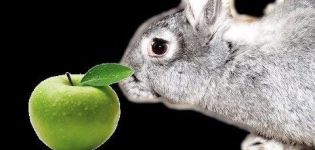How to properly form cucumbers into one stem in a greenhouse in stages
The scheme, in which it is necessary to form cucumbers into one stem, is not suitable for all varieties. It is also not very suitable for planting open ground. Experienced gardeners know this, but beginners often lack clarity in this matter. Let's try to figure out why this formation option is justified when growing cucumbers in a polycarbonate greenhouse.
Classification of cucumbers
At the beginning of each year, gardening shops are striking with an abundance of seeds. It can be very difficult to choose suitable seeds for your summer cottage. In order not to make a mistake and once again not to admire the empty flowers on cucumbers, we learn to understand the main differences of this culture.
Ripening time
Everyone looks at this characteristic, and most often this parameter becomes the main one for a beginner. I read that "ultra-early ripening, cucumbers ripen in 36 days," and happily bought a pack. Everyone wants an early harvest of cucumbers.
Of course, attention should be paid to the timing. This is necessary for planning the harvest for the whole summer, because you want cucumbers not only in June. Cucumbers in August and September will not hurt. Therefore, you need to plant plants with different dates:
- early ripening species (before ripening 32 - 45 days);
- species with an average ripening period (45 - 50 days);
- late-ripening species (from 50 and more).
Variety or hybrid
This characteristic is important if the summer resident wants to receive his seeds. In the case of the F1 hybrid, this is not possible. The seeds do not retain varietal characteristics; there is no point in collecting them for further reproduction. Seeds are taken from varietal cucumber without fear for further use - all the characteristics of the plant are preserved.
Pollination method
It is imperative to pay attention to this characteristic, especially if the cultivation of cucumbers will take place in a polycarbonate greenhouse. According to this characteristic, all varieties and hybrids are divided into three types:
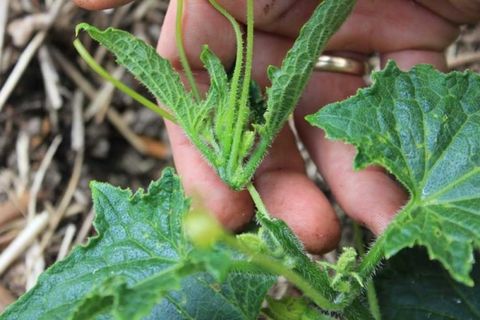
- bee-pollinated;
- self-pollinated;
- not requiring pollination - parthenocarpic type.
Any type can be planted in open ground, but for greenhouses the last two are self-pollinated varieties (hybrids), parthenocarpic. For plants that do not require pollination, it is just important to know how to form cucumbers into one stem.
Branching type
We got to the most important parameter. The type of branching characterizes the ability of a plant to throw out lateral lashes from the buds located in the leaf axils. In the table you can see how all cucumbers are divided according to the type of branching.
The characteristics left without consideration - the purpose of using the fruits and their size - do not affect the formation of the cucumber.
The information from the table can be used to plan the harvest. For example, if you want to quickly get a not very large, but amicable harvest, plant varieties with a weak ability to branch. It will take a little time to leave, you can plant cucumbers more often. If you want to have crispy greens on the table throughout the summer, choose self-regulating hybrids.
Formation schemes
In practice, three schemes for the formation of a cucumber bush have taken root. If you plant several varieties of different branching types, you need to form bushes according to a scheme suitable for each variety:
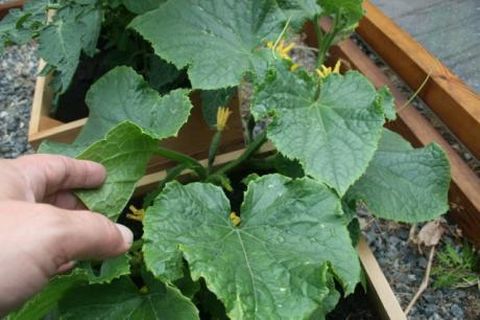
- in the classic way;
- in one stem;
- according to the "Danish umbrella" method.
We form a bush according to the classic scheme
This is a versatile approach, very popular with summer residents who grow cucumbers. A bush formed according to this pattern resembles an inverted herringbone.
As the central conductor grows, it is necessary to carry out a phased removal of stepsons, ovaries and flowers. From the beginning of the stem to 5 leaves, remove everything from the sinuses. Count the next 5 leaves, leave the stepsons in them, but pinch after the first leaf.
Leave 2 leaves on the branches released from the next 3 sinuses, 3 each from the 3 nodes above. Throw the central stem that continues to grow over the top of the trellis and direct it down. At a height of 60 cm from the ground, the crown can be pinched.
1 stalk bush
It will be beneficial for a summer resident to grow a cucumber with a bunch (super bunch) type of fruiting in greenhouses. Have bunch cucumbers ovaries (4 - 7) are formed in the nodes of the central conductor. It turns out a very powerful load on the conductor, therefore, the scheme for keeping a cucumber in one stem is considered optimal.
Pluck the ovaries, stepsons and flowers from the first 4 sinuses. In the subsequent nodes, we leave the ovaries, and pluck out the stepsons one by one along the entire length of the central stem.
Having picked up a weakly branching beam hybrid for your greenhouse, you can significantly save time on pinching bushes. Plus forming in 1 stem - a large harvest per square meter. Achieve it with a denser planting of seedlings.
Experienced summer residents manage to collect 15 kg of bundle-type cucumbers from a unit area in their greenhouse. Naturally, only those who choose the correct molding scheme and do not forget about feeding and watering.
Danish umbrella scheme
Such a formation of cucumbers in a greenhouse for a beginner will seem difficult. It is used for parthenocarpic cultivars for indoor cultivation, grown on a trellis. Liana is divided into 3 zones:
- Zone I - from 0 to 5 knots;
- II zone - from 5 knots to 9;
- III zone - all nodes above 9.
In zone I we blind each node. In zone II, you need to leave 1 ovary in each node, and pull out the stepsons, zone III is the most difficult:
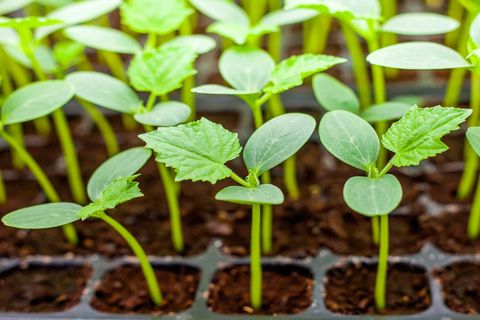
- Leave 2 ovaries in 7 sinuses.
- From the fourteenth node we start up an escape, which we pinch after 2 leaves.
- We blind three knots, in two we launch along a short escape.
- 20 knot is used to obtain a continuation shoot, pinch after 8 leaves.
- The central lash, which has grown to the top of the trellis, is thrown over it and after 3 leaves the crown is pinched off.
- From the continuation shoots, it is permissible to release 3 shoots of the 2nd order.
Farmers use this scheme in the spring in heated greenhouses. Long-fruited varieties are grown for sale. A seemingly complicated scheme for the formation of cucumbers in a greenhouse makes it easier to care for plantings. The lower part of the greenhouse is free, and all the green mass is at the top, it is well lit, and the bottom is ventilated.
Pinching in the old way
The varieties planted in greenhouses are pinched by summer residents in the old way. 7 nodes are counted from the bottom of the bush and the crown is pinched off. Side shoots grow from the sinuses.All of them are not needed, the three most powerful are enough, the rest should be removed. When the side shoots form 4 nodes, their growth point must be pinched.
A few tips from experienced summer residents
Remove no more than 2 stepchildren at a time, if you missed the moment, the length of the side stepchildren exceeded 25 cm, the formation of lashes can lead to the discharge of ovaries and flowers. Do not forget to feed the bushes that have undergone the removal of stepsons... For these purposes, complexes tested by summer residents ("Giant", "Giant") and herbal infusions are suitable. If the weather is damp and cool, spraying the bushes with a fungicide will not hurt.
Good prevention of fungal infections - treatment with the drug "Oxyhom". The agent acts systemically, protects the plant from the inside and outside. If the spores of the fungus get into the wound, "Oxyhom" will neutralize and prevent infection from developing.
If you remove the stepsons laziness
A busy summer resident who rarely visits the garden should seriously approach the choice of varieties (hybrids). Consider hybrids that don't need pinching. It takes less effort to grow these hybrids.
Loyal friends of F1 - a hybrid with a weak branching. At the nodes of the plant, 8 ovaries are formed. The hybrid is pollinated by bees. Diseases are a little susceptible. Keeps productivity during temporary summer cold snaps.
Bouquet F1 is a hybrid of the parthenocarpic type. Side shoots are absent. Up to 5 zelents are formed in the node. Good immunity to powdery mildew, mosaic. The fruit taste is excellent.
The F1 alphabet is a parthenocarpic hybrid. The lateral lashes of the hybrid are rare. In a knot there are up to 5 ovaries. From the central stem of the hybrid, the yield is friendly. The first wave lasts a month, the second wave comes later. The ovaries are formed on the lateral lashes.
